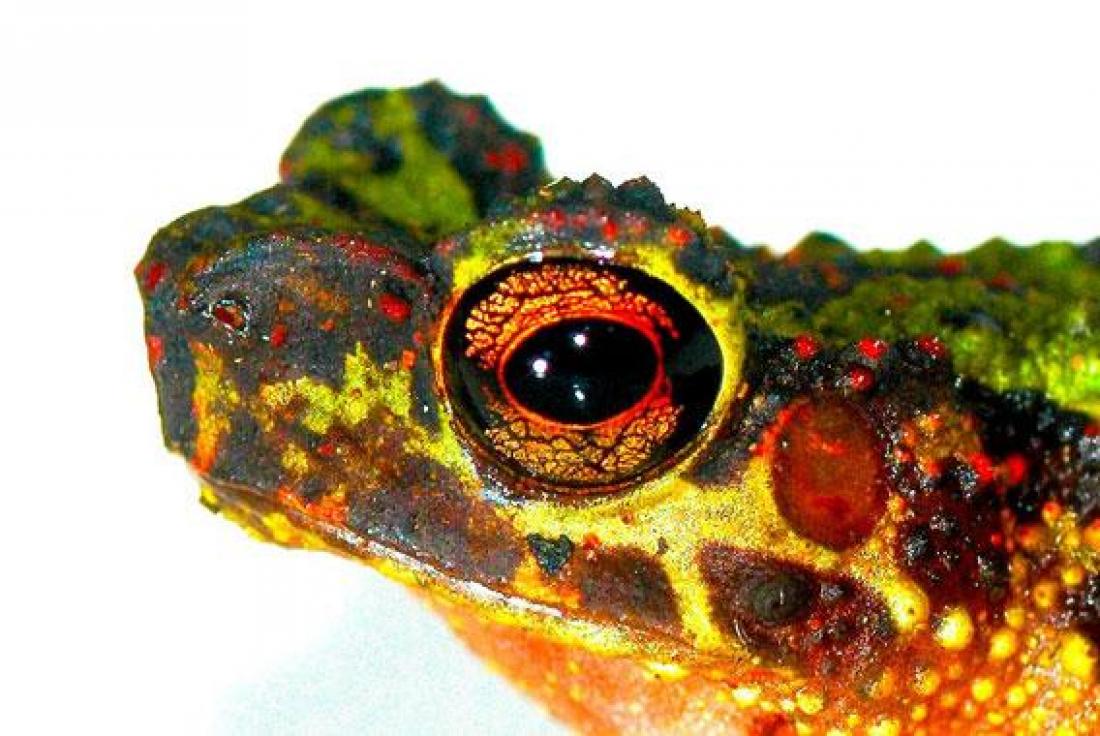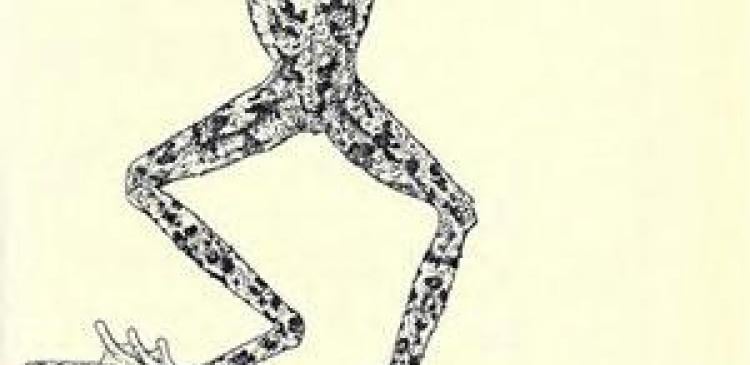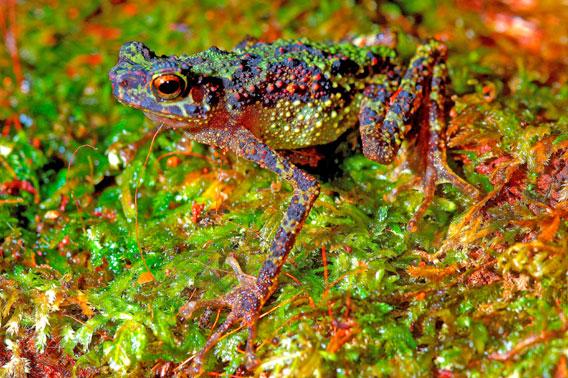Not seen since 1924 and never photographed: an adult female Borneo Rainbow Toad, also referred to as Sambas Stream Toad (Ansonia latidisca).
The Bornean rainbow toad, also known as the Sambas Stream toad (Ansonia latidisca) was rediscovered on Borneo in the Malaysian state of Sarawak by local scientists inspired by a 2010 search for the world's missing amphibians by Conservation International (CI). Leading up to its search CI released the World's Top 10 Most Wanted Lost Frogs (out of a hundred being searched for): the Bornean rainbow toad was listed as number 10.
Led by Dr. Indraneil Das with Universiti Malaysia Sarawak (UNIMAS), who last years discovered a pea-sized frog in Borneo, researchers found the long-elusive Bornean rainbow toad hanging out 2 meters up a tree. The species was found at night in a little-explored area of the Gunung Penrissen mountain range. Several early expeditions failed, but once the group included higher altitudes they were actually able to locate three individuals of the long-lost toad.
Prior to its rediscovery the toad was only known from three individuals and a single black-and-white illustration made in the 1920s.
"When I saw an email with the subject 'Ansonia latidisca found' pop into my inbox I could barely believe my eyes. Attached was an image—proof in the form of the first ever photograph of the colorful and gangly tree-dwelling toad. The species was transformed in my mind from a black and white illustration to a living, colorful creature," amphibian specialist Dr. Robin Moore of Conservation International, who launched the global search for lost amphibians, said in a press release.
Unfortunately the habitat in which it is found it not currently under protection and is threatened by resort development, poaching, and fragmentation. The exact location of the rediscovery of the frog is being withheld given concerns it would become targeted for the pet trade, especially with its bright and unique coloring.
CI's Global Search for Lost Amphibians covered five continents and 21 countries looking for 100 amphibians, many not seen for decades. The official search only found four of the lost hundred, an additional sign that many of the world's amphibians are simply lost for good.
Amphibians are undergoing an extinction crisis unparalleled to date in the animal world. Currently the IUCN Red List estimates that 41 percent of the world's amphibians are threatened with extinction. Frogs, salamanders, and worm-like caecilians have been battered worldwide by habitat loss, pollution, agricultural chemicals, overexploitation, and climate change. Yet the biggest impact on amphibians appears to be a fungal disease called chytridiomycosis. This amphibian-plague has wiped out whole species even in otherwise areas. Experts say that in the past 3 decades it is likely at least 120 amphibians have gone extinct. In a few cases captive populations in zoos have become a species' last stand. However, this rediscovery of the Bornean rainbow toad highlights that there is still hope for some of the world's amphibians.
"Thrilling discoveries like this beautiful toad, and the critical importance of amphibians to healthy ecosystems, are what fuel us to keep searching for lost species," Dr. Das said in a press release. "They remind us that nature still holds precious secrets that we are still uncovering, which is why targeted protection and conservation is so important. Amphibians are indicators of environmental health, with direct implications for human health. Their benefits to people should not be underestimated."
Of course, rediscovering the Bornean rainbow toad is only the start. Now conservation measure are needed to protect it from vanishing again.
THE TOP 10 “LOST” AMPHIBIAN SPECIES:
• Golden toad (Incilius periglenes) Costa Rica - last seen in 1989
• Gastric brooding frog (Rheobatrachus vitellinus and R. silus) Australia - last seen in 1985
• Mesopotamia Beaked Toad (Rhinella rostrata) Colombia - last seen in 1914
• Jackson's climbing salamander (Bolitoglossa jacksoni) Guatemala - last seen in 1975
• African Painted Frog (Callixalus pictus) Dem. Republic of Congo/Rwanda - last seen in 1950
• ((FOUND)): Rio Pescado Stubfoot Toad (Atelopus balios) Ecuador
• Turkestanian salamander (Hynobius turkestanicus) Kyrgyzstan/Tajikistan/Uzbekistan - last seen in 1909
• Scarlet frog (Atelopus sorianoi) Venezuela - last seen in 1990
• Hula painted frog (Discoglossus nigriventer) Israel - last seen in 1955
• ((FOUND)): Sambas Stream Toad (Ansonia latidisca) Borneo - last seen in the 1920s





